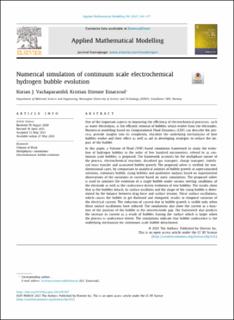| dc.description.abstract | One of the important aspects in improving the efficiency of electrochemical processes, such as water electrolysis, is the efficient removal of bubbles which evolve from the electrodes. Numerical modelling based on Computational Fluid Dynamics (CFD) can describe the process, provide insights into its complexity, elucidate the underlying mechanisms of how bubbles evolve and their effect as well as aid in developing strategies to reduce the impact of the bubble.
In this paper, a Volume of Fluid (VOF) based simulation framework to study the evolution of hydrogen bubbles in the order of few hundred micrometers, refered to as continuum scale bubbles, is proposed. The framework accounts for the multiphase nature of the process, electrochemical reactions, dissolved gas transport, charge transport, interfacial mass transfer and associated bubble growth. The proposed solver is verified, for two-dimensional cases, by comparison to analytical solution of bubble growth in supersaturated solutions, stationary bubble, rising bubbles and qualitative analysis based on experimental observations of the variations in current based on static simulations. The proposed solver is used to simulate the evolution of a single bubble under various wetting conditions of the electrode as well as the coalescence driven evolution of two bubbles. The results show that as the bubbles detach, its surface oscillates and the shape of the rising bubble is determined by the balance between drag force and surface tension. These surface oscillations, which causes the bubble to get flattened and elongated, results in temporal variation of the electrical current. The reduction of current due to bubble growth is visible only when these surface oscillations have reduced. The simulations also show the current as a function of the position of the bubble in the interelectrode gap. The framework also predicts the increase in current as a result of bubbles leaving the surface which is larger when the process is coalescence driven. The simulations indicate that bubble coalescence is the underlying mechanism for continuum scale bubble detachment. | en_US |

